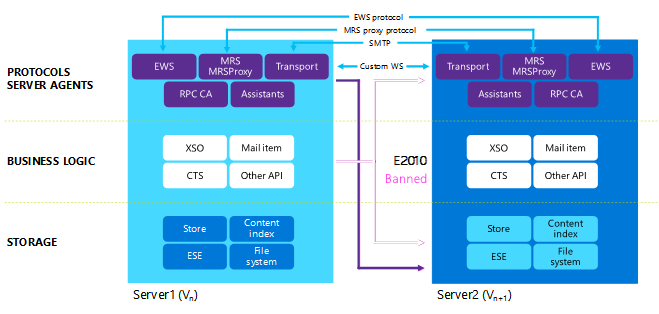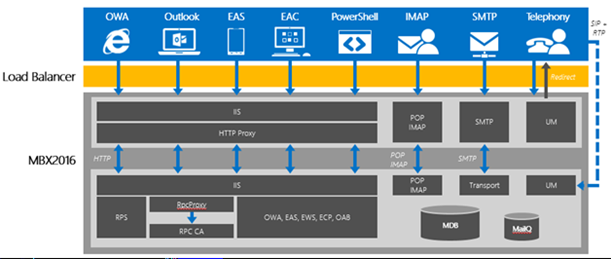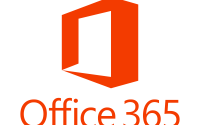Exchange Server 2016 Architecture
Here in this blog we are discussing about the Exchange Server 2016 Architecture, unlikely the older version of Exchange server, Exchange 2016 is quite different. As described on our previous blog, On Exchange 2016 Architecture has been modified and that Single BOX is accumulated with CAS, HUB Transport and Mailbox know as Mailbox Role and another Role is Edge Transport Role. So in Summary now we do have only Two major roles on Exchange 2016 and they are
-
Mailbox Role
-
Edge Transport Role.
With the change on the Roles of the Exchange 2016, obviously it will bring utter effect on Architecture too, before going to deploy Exchange 2016 we will be required enough good knowledge on its Architecture and design. Hence this blog will be only focusing on Architecture Knowledge and design of Exchange 2016.
Exchange Server 2016 uses a single Building block architecture that provides email services for deployment at all sizes, from small organization to the largest Multi-national corporations. This architecture is describing in the below diagram.

Server communication architecture
Communication between Exchange 2016 servers and past and future versions of Exchange occurs at the protocol layer. Cross-layer communication isn’t allowed. This communication architecture is summarized as “every server is an island”. This architecture has the following benefits:
- Reduced inter-server communications.
- Version-aware communications.
- Isolated failures.
- Integrated design inside each server.
Protocol layer communication between Exchange 2016 servers is shown in the following diagram.

Server Role Architecture
In case of Exchange 2016 we do have only TWO ROLES, whose architecture is defined below:
- Mailbox servers contain the transport services that are used to route mail.
- Mailbox servers contain mailbox databases that process, render, and store data.
- Mailbox servers contain the client access services that accept client connections for all protocols. These frontend services are responsible for routing or proxy connections to the corresponding backend services on a Mailbox server. Clients don’t connect directly to the backend services.
- Mailbox servers contain the Unified Messaging (UM) services that provide voice mail and other telephony features to mailboxes.
-
You manage Mailbox servers by using the Exchange admin center (EAC) and the Exchange Management Shell.
- Edge Transport servers handle all external mail flow for the Exchange organization.
- Edge Transport servers are typically installed in the perimeter network, and are subscribed to the internal Exchange organization. The EdgeSync synchronization process makes recipient and other configuration information available to the Edge Transport server as mail enters and leaves the Exchange organization.
- Edge Transport servers provide antispam and mail flow rules as mail enters and leaves your Exchange organization.
- Can manage Edge Transport servers by using the Exchange Management Shell.
High Availability
The another major factor that required for the salient deployment of Exchange 2016 is to know about its HA. How can we achieve HA for the different roles of Exchange 2016.
A database availability group (DAG) is the fundamental element of the high availability and site resilience framework that’s built into Exchange 2016. A DAG is a group of Mailbox servers that host a set of databases and provides automatic, database-level recovery from database, network, and server failures. And DAGs in Exchange 2016 have been improved compared to Exchange 2013. Although the configuration is same on the matter of Exchange 2013. Clients do not connect directly to MBX2016 back-end end points; connectivity is through client access services Evolution of E2010 DAG
For HA of mailbox, as of Exchange 2013 it supports only 16 mailboxes for DAG connectivity.
- The Transport service makes redundant copies of all messages in transit. This feature is known as shadow redundancy.
- The transport service makes redundant copies of all delivered messages. This feature is known as Safety Net.
- In Exchange 2016, a DAG represents a transport high availability boundary. You can achieve site resilience by spanning a DAG across multiple Active Directory sites.
- In Exchange 2016, transport high ability is more than a best effort for message redundancy, because redundancy doesn’t depend on supported features of the sending mail server. Therefore, you can say that Exchange 2016 attempts to guarantee message redundancy by keeping multiple copies of messages during and after delivery.
Client Access Protocol Architecture
The Client access services on Exchange 2016 Mailbox server are responsible for accepting all forms of client connection. The client access services proxy these connections to backend services on the destination Mailbox server. The client machine is not allowed to communicate directly to the backend services. That means
- All connections are MAPI/HTTP
- No longer uses intermediary RPC components on client or server.
- ROPs (Remote Operations) are still used, just sent to Exchange directly over HTTP
- Client advertises support and server returns configuration settings
-
Remove RPC Stack Dependency
Below is the Diagram of for client communication with Exchange 2016


